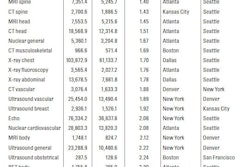Dear AuntMinnie Member,
Well, the unthinkable finally happened this weekend as the U.S. House of Representatives passed healthcare reform legislation. President Barack Obama is expected to sign the bill today.
While many of the bill's broader provisions are well known, the legislation's impact on radiology is still up in the air. Most significant, the House and Senate versions of the bill contain different language regarding the utilization rate for imaging equipment -- and both versions differ from a 90% utilization rate proposed by the U.S. Centers for Medicare and Medicaid Services last year.
That's the downside. The potential upside is that the effects of any reimbursement cuts could be mitigated by the bill bringing millions of currently uninsured Americans into the healthcare system -- a potential boon for lower-cost services such as screening mammography. Indeed, shares of healthcare providers and medical device firms rose on Wall Street on Monday.
Also important, passage of the bill removes a major cloud of uncertainty over healthcare that caused many hospitals to put capital equipment purchasing on hold. It's hoped that buying will return as healthcare providers figure out how to operate and prosper under the new system -- as they have after every other major regulatory change in healthcare in the past several decades.
Learn more about what healthcare reform means for radiology by clicking here for an article by associate editor Kate Madden Yee, and continue to visit our Imaging Center Digital Community as we follow this developing story.
FDA nixes handheld imaging app
In other regulatory news, the U.S. Food and Drug Administration (FDA) may be about to put the brakes on one of the most exciting areas of radiology: image review on handheld devices. That's according to a story by senior editor Erik L. Ridley that we're featuring in our Advanced Visualization Digital Community.
The agency recently rejected a 510(k) filing for an image review application on Apple's iPhone device, stating that there was no "substantially equivalent" software on the market that would enable the company to use the less rigorous 510(k) process. Now, the company is faced with having to conduct clinical trials in support of a premarket approval (PMA) application for the software.
Is this yet another example of the FDA making much ado about nothing? Or are handheld devices such as iPhones simply not ready for diagnostic use? Learn more by clicking here, or visiting the community at av.auntminnie.com.



















